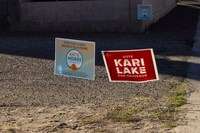There are two resources essential to any political campaign: time and money. And if pressed, most campaign staffers will tell you that lawn signs, those little placards that pop up on highway medians every other October, are a giant waste of both.
Suddenly, lawn signs seem useful — though not for winning votes

But that was a few years ago in another political era. Now lawn signs might have a new use, one well-suited to the moment: demonstrating to skeptics that a candidate actually has the support reflected in election results.
This week, The Washington Post interviewed Arizona Secretary of State Katie Hobbs, whose bid for governor in that state is projected by the Associated Press and Edison Research to have been successful. Hobbs ran against Kari Lake, a former television news host who made rejection of election results central to her candidacy. So in her conversation with The Post, Hobbs pledged to continue to strengthen election systems in her state.
But then there was the conversation about lawn signs.
“Hobbs said she was fairly certain she would win, based on her campaign’s internal polling data and the voters she spoke to along the way,” The Post’s Yvonne Wingett Sanchez and Isaac Stanley-Becker wrote. “Sometimes doubt crept in — like when donors complained that she wasn’t talking enough about democracy issues, or moaned that she didn’t put up campaign signs on street corners.”
To be very clear, that latter complaint is part of every campaign. Donors are important for that money resource but often also take up a lot of time with their own theories of what’s important in an election. Lawn signs, as mentioned above, are not terribly important, but lots of people think they are. Campaign staffers I’ve spoken with in the past have admitted placing lawn signs specifically so that the candidate or donors see them and feel as though they’re out there.
But again, this wasn’t a normal election. This was Hobbs battling Lake, a candidate following Donald Trump’s playbook of sowing doubt about voting before Election Day and then elevating isolated problems as cause for skepticism afterward. On Thursday, Lake released a video pledging to her supporters that she would continue the legal fight to be seated, again echoing Trump.
When the AP called the race for Hobbs, Fox News reporter Kevin Corke did his best to raise viewer eyebrows about the result.
“Katie Hobbs, who you probably recall wouldn’t debate — some even said she barely campaigned,” Corke said on “Fox & Friends.” “And yet somehow she managed to acquire more than 1.2 million votes, just enough, apparently, to best Kari Lake in Arizona’s gubernatorial race.”
That probably sounds familiar. In the aftermath of the 2020 presidential contest, Trump and his supporters made similar claims about Joe Biden: He hardly campaigned; there’s no way he got that many votes. Part of that rhetoric was just dishonesty. Part of it, too, was that Trump supporters — no doubt like many Lake supporters — simply didn’t know anyone who’d voted for his opponent.
“Isn’t it interesting that I can’t find anyone who will admit that they voted for Joe Biden?” said Republican secretary of state candidate Mark Finchem (R) in September. Asked if it was possible he simply didn’t know many of the hundreds of thousands of Biden voters in the state, Finchem replied, “In a fantasy world, anything’s possible.”
So now we come back to lawn signs. Lawn signs are, if nothing else, a public manifestation of support. They can be misleading as an indicator — they probably are misleading, in the way that crowd size can be. (Are rally attendees even registered to vote? Etc.) But they are unquestionably manifestations of the sort that might make it harder for an observer to pretend that an opposing candidate is entirely unsupported.
Shortly before the 2020 election, I went to Scranton, Pa., to evaluate how the Biden and Trump campaigns were making their final pitch to voters. Biden’s team was running a coordinated get-out-the-vote effort aimed at ensuring that their voters cast ballots. Trump’s team and the local Republican Party were passing out lawn signs and having loud parades of cars drive through town, what campaigns call (and often deride) as “visibility” efforts.
“Trump’s insistence on his popularity — [like] the president’s embrace of parades and caravans — help amplify the sense that he’s sitting atop a massive reservoir of support that remains untapped by pollsters,” I wrote at the time. “Visibility may not turn out voters, but it may convince people that you have a lot of voters in a state, a distinction that’s useful if you want to, say, claim that you lost only because of fraud.”
As Trump did lose, it turned out.
Again, lawn signs are expensive and annoying. (Try fielding 10 calls a day from people miles apart who want a lawn sign stuck in their yard.) They don’t do much to convince people to vote for a candidate. But in this era of using skepticism as a predicate for reversing an election outcome, simply demonstrating broad geographic support, however Potemkin, might have more use than it once did.






